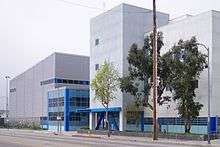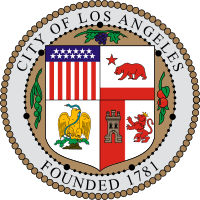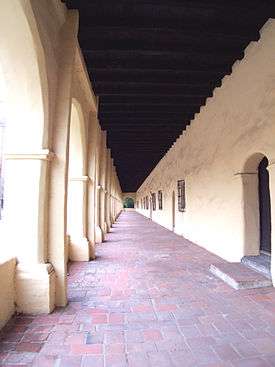North Hollywood, Los Angeles
| North Hollywood, Los Angeles | |
|---|---|
| Neighborhood of Los Angeles | |
| North Hollywood | |
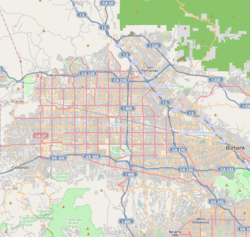 North Hollywood, Los Angeles Location within Los Angeles/San Fernando Valley | |
| Coordinates: 34°10′26″N 118°22′44″W / 34.1739°N 118.3790°WCoordinates: 34°10′26″N 118°22′44″W / 34.1739°N 118.3790°W | |
| Country |
|
| State |
|
| County |
|
| City |
|
North Hollywood is a neighborhood in the San Fernando Valley region of the city of Los Angeles. It is home to the NoHo Arts District and the Academy of Television Arts & Sciences, and it has seven public and eight private schools.
There is a municipal park and a recreation center. The neighborhood is an important transportation center, and it is also a place where many notable people have lived or worked.
North Hollywood was established by the Lankershim Ranch Land and Water Company in 1887. It was first named "Toluca" before being renamed "Lankershim" in 1896 and finally "North Hollywood" in 1927. It is not contiguous with Hollywood, being separated by other parts of the San Fernando Valley and the Hollywood Hills.
Demographics
The 2000 U.S. census counted 77,848 residents in the 5.87-square-mile North Hollywood neighborhood—or 13,264 people per square mile, about an average population density for the city but among the highest for the county. In 2008, the city estimated that the population had increased to 87,241. In 2000 the median age for residents was 30, considered an average age for city and county neighborhoods; the percentage of residents aged 19 to 34 was among the county's highest.[1]
The neighborhood was considered "moderately diverse" ethnically within Los Angeles. The breakdown was Latinos, 57.7%; whites, 27%; Asians, 5.7%; blacks, 5.6%; and others, 4%. Mexico (43.2%) and El Salvador (16%) were the most common places of birth for the 46.4% of the residents who were born abroad—a high percentage for Los Angeles. The percentages of never-married men and never-married women were among the county's highest.[1]
The median yearly household income in 2008 dollars was $42,791, considered average for the city but low for the county. The percentages of households that earned $40,000 or less were high for the county. Renters occupied 75.4% of the housing stock, and house- or apartment-owners held 24.6%.[1]
Geography
North Hollywood is bordered on the north by Sun Valley and on the northeast and east by Burbank. Toluca Lake borders North Hollywood on the southeast and south, and Studio City abuts it on the southwest. It is flanked by Valley Village and Valley Glen on the west.[2]
"North Hollywood" is a broad term; some may generally refer to the area between Burbank and State Route 170 south of Sherman Way as "North Hollywood", even including areas not strictly a part of the neighborhood.
Nearby places
Relation of North Hollywood to nearby places, not necessarily contiguous:[2][3]
 |
Panorama City & Arleta | Sun Valley | Bob Hope Airport |  |
| Valley Village & Valley Glen | |
Burbank | ||
| ||||
| | ||||
| Studio City & Los Angeles Valley College | Toluca Lake & Studio City | Toluca Lake |
History
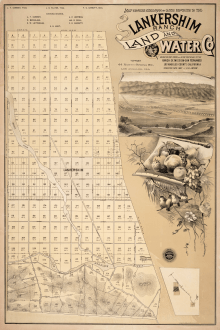
Before annexation
North Hollywood was once part of the vast landholdings of the Mission San Fernando Rey de España, which was confiscated by the government during the Mexican period of rule.
A group of investors assembled as the San Fernando Farm Homestead Association purchased the southern half of the Rancho Ex-Mission San Fernando. The leading investor was Isaac Lankershim, a Northern California stockman and grain farmer, who was impressed by the Valley's wild oats and proposed to raise sheep on the property. In 1873, Isaac Lankershim's son and future son-in-law, James Boon Lankershim and Isaac Newton Van Nuys, moved to the San Ferndando Valley and took over management of the property. Van Nuys thought the property could profitably grow wheat using the dryland farming technique developed on the Great Plains and leased land from the Association to test his theories. In time the Lankershim property, under its third name, the Los Angeles Farming and Milling Company, would become the world's largest wheat-growing empire.[4][5]
In October 1887, J.B. Lankershim and eight other developers organized the Lankershim Ranch Land and Water Company, purchasing 12,000 acres (49 km2) north of the Cahuenga Pass from the Lankershim Farming and Milling Company.[6] Lankershim established a townsite which the residents named Toluca along the old road from Cahuenga Pass to San Fernando. On April 1, 1888, they offered ready-made small farms for sale, already planted with deep-rooted deciduous fruit and nut trees—mostly peaches, pears, apricots, and walnuts—that could survive the rainless summers of the Valley by relying on the high water table along the Tujunga Wash rather than surface irrigation.[7][8]
.jpg)
The land boom of the 1880s went bust by the 1890s, but despite another brutal drought cycle in the late 1890s, the fruit and nut farmers remained solvent. The Toluca Fruit Growers Association was formed in 1894. The next year the Southern Pacific opened a branch line slanting northwest across the Valley to Chatsworth. The Chatsworth Limited made one freight stop a day at Toluca, though the depot bore the new name of Lankershim. With the post office across the street being called Toluca, controversy over the town's name continued, and the local ranchers used to quip, "Ship the merchandise to Lankershim, but bill it to Toluca." In 1896, under pressure from Lankershim, the post office at Toluca was renamed "Lankershim" after his father, although the new name of the town would not be officially recognized until 1905.[9][10]
By 1903, the area was known as "The Home of the Peach". In 1912, the area's major employer, the Bonner Fruit Company, was canning over a million tons of peaches, apricots, and other fruits.[11] When the Los Angeles Aqueduct opened in 1913, Valley farmers offered to buy the surplus water, but the federal legislation that enabled the construction of the aqueduct prohibited Los Angeles from selling the water outside of the city limits.[12]
At first resistance to the real-estate development and downtown business interests of Los Angeles remained strong enough to keep the small farmers unified in opposition to annexation. However, the fruit packing company interests were taken over by the Los Angeles interests. The two conspired to decrease prices and mitigate the farmers' profit margins, making their continued existence tenuous. When droughts hit the valley again, rather than face foreclosure, the most vulnerable farmers agreed to mortgage their holdings to the fruit packing company and banks in Los Angeles for the immediate future and vote on annexation.
After annexation
West Lankershim (more or less today's Valley Village) agreed to be annexed to the City of Los Angeles in 1919, and Lankershim proper in 1923.[13][14] Much of the promised water delivery was withheld, and many of the ranchers one by one had their holding foreclosed or transferred to the packing companies. In turn, these were bought up by the real-estate developers and by the late 20's a massive effort was underway to market the area to prospective home owners throughout the country. As part of this effort, in 1927, in an effort to capitalize on the glamour and proximity of Hollywood, Lankershim was renamed "North Hollywood".[11] The result was a massive development of housing which transformed the area into a suburban development of Los Angeles.
Starting in the late fifties, many of the original owners were aging, and their children were moving to other areas. School integration in the subsequent years, blockbusting, and subsequent ethnic turmoil encouraged many remaining families to move out, who in turn were replaced with black and Hispanic families moving from the downtown areas. By the 1990s, the demographic changes had almost completely transformed the region.
North Hollywood was also the site of an infamous shootout that took place in 1997.
21st century
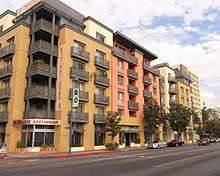
North Hollywood is a diverse area with significant sized populations including Latino, Asian American, Armenian American, African American, Jewish, Jamaican American, Middle Eastern, Iranian American, German American, and Filipino American populations.
Since 2000, the community has been undergoing many changes and developing, thanks in large part to the formation of the 743-acre North Hollywood Development District and the subsequent NoHo Commons projects.[15] These projects attempt to recapture North Hollywood's historic image and restore the area's economy. Consequently, North Hollywood's landscape has been transformed, with condominium towers (including a 15-story building on Lankershim Boulevard) appearing in the midst of older one-story bungalows and small apartment complexes. The community is changing from a suburb-like setting into a metropolitan center, in large part as a result of the construction of Metro Stations for the Red Line and the Orange Line, two lines that have made the neighborhood into a regional hub for the San Fernando Valley. Medium- and high-density developments are being built around the Metro Station, particularly in the NoHo Arts District, with the intent of creating a walkable urban village.
In 2015 Lankershim Boulevard in North Hollywood was part of the first San Fernando Valley CicLAvia, an event sponsored by the Los Angeles County Metropolitan Transportation Authority in which major roads are temporarily closed to motorized vehicle traffic and used for recreational human-powered transport.[16]
Attractions
_2015-02-15.jpg)
North Hollywood is home to the Academy of Television Arts & Sciences.
Pierce Brothers Valhalla Memorial Park is located in the area, and is notable for its special section memorializing aviators.
Universal Studios is also located on the border between Hollywood and North Hollywood, easily accessible through one of NoHo's main streets, Lankershim Blvd.
NoHo Arts District
Business and theatre owners in the Universal City/North Hollywood Chamber of Commerce formed the idea of establishing a theatre and arts district in 1992 with support from L.A. Department of Cultural Affairs. They chose "NoHo" as it not only reveals its location, but also plays off the well-known "SoHo" Arts District of New York City.
Central to the new NoHo Arts District are contemporary theaters, art galleries, cafes, and shops. The area features more than 20 professional theatres producing new work and classics, diverse art galleries, public art and professional dance studios. The district also features the largest concentration of music recording venues west of the Mississippi.
The theater district includes two new large venues that expand upon existing theatres, the newly redesigned NoHo Arts Center (formerly the American Renegade Theatre), and the redesigned Historical El Portal. They add to the existing 31 theatres located in and around the NoHo Arts District. New mixed-use development, the NoHo Commons, is planned near the NoHo Arts District's commercial core and subway station by Los Angeles developer J.H. Snyder Company.
The $100-million, 292-unit loft apartment project by Snyder is the first segment to be completed of NoHo Commons, part of a "transit village" rising at the terminus of the Metro Red Line subway and the Orange Line busway. Also planned are hundreds of other apartments, condos, stores and other developments, including a high school.
NoHo 14 is a 14-story apartment building with 180 units on Lankershim Boulevard and Cumpston Street that is complete and now leasing. The historic North Hollywood train depot at Lankershim and Chandler Boulevards, is being restored to its 1920s condition. The old train depot sits on land owned by the Metropolitan Transportation Authority, across from the Metro Red Line subway station and next to the termination of the Orange Line bus line.
In fall of 2009, J.H. Snyder Company plans to finish a mixed-use structure including a seven screen Laemmle movie theatre, five story office building and 150 residential units on the south end of NoHo Commons.[17]
In the future, North Hollywood plans a $1 billion mixed-use development at Lankershim and Chandler called the "NoHo Art Wave", surrounding the Metro Red and Orange line terminals. The project, "touted as L.A.'s biggest transit project,"[18] would re-develop 15.6 acres (63,000 m2) with 1,720,000 square feet (160,000 m2) of commercial and residential space, including 562 residential units and three high-rise office towers. The project was awarded to Lowe Enterprises by the Los Angeles Metro board and will be designed by architects AC Martin Partners.[19][20]
Government and infrastructure
The Los Angeles County Department of Health Services has the Antelope Valley Area Health Office and the San Fernando Valley Area Health Office in a facility in North Hollywood.[21][22] The department operates the North Hollywood Health Center in North Hollywood.[23] In addition the department operates the Glendale Health Center in Glendale, serving North Hollywood.[24]
The United States Postal Service operates the North Hollywood Post Office at 7035 Laurel Canyon Boulevard,[25] the Valley Plaza Post Office at 6418 Bellingham Avenue,[26] and the Victory Center Post Office at 6535 Lankershim Boulevard.[27]
Transportation

The L.A. county Transportation Commission took years, but finally in 1990 approved the construction of the subway connecting North Hollywood to Hollywood, East Hollywood, Koreatown, Westlake and downtown Los Angeles along the Metro Rail Red Line. That followed the Los Angeles City Council unanimously endorsing North Hollywood as the northern terminal of the Red Line. The final route has termini at Union Station and North Hollywood. The North Hollywood Metro Subway station opened in June 2000. Close to half a million people took advantage of free rides on the 17.4-mile (28.0 km) Red Line subway in its first weekend in operation. The station is the starting point for the Red Line Metro system, which cost $4.5 billion to construct.
The tunnel to connect the Metro Red Line Hollywood leg to the San Fernando Valley extension cost $136 million. It included the cost of digging a tunnel under the Santa Monica Mountains. The tunneling work was done by a Traylor Brothers/Frontier-Kemper joint venture. The Santa Monica Mountains Conservancy and the Sierra Club had fought to prevent the tunneling but ultimately lost. Environmentalists were concerned that the removal of billions of gallons of ground water might affect springs, wildlife and vegetation.
Tunneling from North Hollywood for the subway started in 1995. Workers dug 70 feet (21 m) deep using tunneling machines. Work progressed an average of 50 to 200 feet (61 m) daily, performed by work crews round-the-clock six days a week. The machines used bore through soil that once lined the bottoms of ancient oceans.
.jpg)
The two tunnels between the North Hollywood and Universal City stations were a total of 10,541 feet (3,213 m). The cost of building the two tunnels was $65.4 million and involved 250 workers.
A further Red Line extension was replaced by the Metro Orange Line bus rapid transit. Its terminus is located across the street from the subway station. This expanded the station area into a transit hub, and many local and rapid buses now stop at the station. Proposals have been made to extend the Red Line northeasterly to Bob Hope Airport in Burbank and the Burbank Metrolink station in central Burbank, or to extend it in a northwesterly direction along Lankershim Boulevard and eventually to Sylmar, a proposal which was mentioned in at least one published account in the press by former Los Angeles Mayor Antonio Villaraigosa. Neither project is currently funded nor is in Metro's Long Term Transportation Plan.
Education
Eighteen percent of North Hollywood residents aged 25 and older had earned a four-year degree by 2000, an average figure for both the city and the county. The percentage of the same-age residents with less than a high school diploma was high for the county.[1][28]
Schools within the North Hollywood boundaries are:[29]
Public
- Bellingham Primary Center Elementary School, 6728 Bellingham Avenue
- Fair Avenue Elementary School, 6501 Fair Avenue
- Lankershim Elementary School, elementary, 5250 Bakman Avenue
- Maurice Sendak Elementary School, 11414 West Tiara Street
- Oxnard Street Elementary School, 10912 Oxnard Street
- Victory Boulevard Elementary School, 6315 Radford Avenue
- James Madison Middle School, 13000 Hart St
- Roy Romer Middle School, 6501 Laurel Canyon Boulevard
- North Hollywood High School, 5231 Colfax Avenue in Valley Village
- East Valley High School, 5525 Vineland Avenue
- North Hollywood Adult Learning Center, LAUSD Adult Education, 10952 Whipple Street[30]
Private

- Dubnoff Center for Child Development, K-12, 10526 Dubnoff Way. The school's main building was designed in 1965 by Ena Dubnoff in association with Flores, Gelman and Green.
- San Fernando Valley Professional School, K-12, 6215 Laurel Canyon Boulevard
- St. Patrick Elementary School, 10626 Erwin Street
- Montessori Academy of North Hollywood, elementary, 6000 Ensign Avenue
- Laurel Hall, elementary, 11919 Oxnard Street
- Oakwood High School, 11600 Magnolia Blvd
- Or Hachaim Academy, elementary, 6021 Laurel Canyon Boulevard
- St. Paul's First Lutheran, elementary, 11330 McCormick Street
- The Wesley School, elementary, 4832 Tujunga Avenue
- St. Charles Borromeo, elementary, 10650 Moorpark Street
Parks and recreation
The North Hollywood Recreation Center is mostly in North Hollywood, with a portion in Valley Village.[31][32] The park has an auditorium, lighted indoor baseball diamond courts, lighted outdoor baseball diamonds, lighted outdoor basketball courts, a children's play area, lighted handball courts, picnic tables, an outdoor unheated seasonal pool, and lighted tennis courts. In addition the center has an indoor gymnasium which can be used as a second auditorium and a community room; the gymnasium's capacity is 250 people.[32]
The Valley Plaza Recreation Center in North Hollywood includes an auditorium, barbecue pits, a lighted baseball diamond, lighted outdoor basketball courts, a children's play area, a 40-person community room, a lighted American football field, an indoor gymnasium without weights, an outdoor gymnasium without weights, picnic tables, lighted tennis courts, and unlighted volleyball courts.[33] The Jamie Beth Slavin Park, an unstaffed pocket park with unlighted outdoor basketball courts, a children's play area, and picnic tables, is in North Hollywood.[34]
Notable people
|
|
References
Notes
- 1 2 3 4 "North Hollywood," Mapping L.A., Los Angeles Times
- 1 2 Colored map, Mapping L.A., Los Angeles Times
- ↑ Bing maps
- ↑ Link 1991, p.27
- ↑ Roderick 2001, pp. 32–34, 44–45
- ↑ Link 1991, p. 31
- ↑ Jorgenson 1982, p. 82
- ↑ Link 1991, pp. 31, 33
- ↑ Link 1991, pp. 34–35
- ↑ Roderick 2001. p. 46
- 1 2 Bearchell and Fried 1988, p. 124
- ↑ Bearchell and Fried 1988, p. 121
- ↑ Roderick 2001, p. 62–63
- ↑ "City of Los Angeles Annexation and Detachment Map" (PDF). Retrieved 16 May 2009.
- ↑ "NoHo Commons Third Phase Breaks Ground". Diamondwest.net. Retrieved 2013-05-10.
- ↑ "Valley CicLAvia Crowd Estimated At 100K". CBS Los Angeles. 2015-03-23. Archived from the original on 2015-03-24.
- ↑ "J.H. Snyder Co. Announces Movie Theater, Office Building to Be Part of New Project in North Hollywood Arts District". Business Wire. November 20, 2006.
- ↑ http://patch.com/california/northhollywood/metro-projects-in-noho-arts-district-delayed
- ↑ Thursday, October 11, 2007, by Eric (2007-10-11). "First Look: Your $1 Billion NoHo Art Wave - Curbed LA". La.curbed.com. Retrieved 2013-05-10.
- ↑ Zach Behrens (2007-09-28). "A new NoHo could be around the corner". LAist. Retrieved 2013-05-10.
- ↑ "Antelope Valley Area Health Office." Los Angeles County Department of Health Services. Retrieved on March 27, 2010.
- ↑ "SPA2- San Fernando Valley Area Health Office." Los Angeles County Department of Health Services. Retrieved on March 17, 2010.
- ↑ "North Hollywood Health Center." Los Angeles County Department of Health Services. Retrieved on March 17, 2010.
- ↑ "Glendale Health Center." Los Angeles County Department of Health Services. Retrieved on March 17, 2010.
- ↑ "Post Office Location - NORTH HOLLYWOOD." United States Postal Service. Retrieved on December 6, 2008.
- ↑ "Post Office Location - VALLEY PLAZA." United States Postal Service. Retrieved on December 6, 2008.
- ↑ "Post Office Location - VICTORY CENTER." United States Postal Service. Retrieved on December 6, 2008.
- ↑ "Less Than High School," Mapping L.A., Los Angeles Times
- ↑ "North Hollywood: Schools," Mapping L.A., Los Angeles Times
- ↑ http://www.nvoc.org/index.html
- ↑ "Map." Valley Village Neighborhood Council. Retrieved on September 21, 2009.
- 1 2 "North Hollywood Recreation Center." City of Los Angeles. Retrieved on March 19, 2010.
- ↑ "Valley Plaza Recreation Center." City of Los Angeles. Retrieved on March 19, 2010.
- ↑ "Jamie Beth Slavin Park." City of Los Angeles. Retrieved on March 19, 2010.
- ↑ Hedda Hopper, "Autry Can't Get Around to Resting," Los Angeles Times, July 31,1949, page D-1
- ↑ "Brennan Boesch Stats, Video Highlights, Photos, Bio | yankees.com: Team". Detroit.tigers.mlb.com. Retrieved 2013-05-10.
- ↑ Location of the Burkhalter residence on "Mapping LA."
- ↑ "City Council Candidates," Los Angeles Times, March 12, 1961. page SF-4
- ↑ "April 1, 2003". Loveline. April 1, 2003.
- ↑ Dixon, Chris (September 4, 2005). "A Rhinestone Cowboy Who Grabbed Cars by the Horns.". The New York Times.
Cohn made his mark by adorning Western-cut suits with galaxies of rhinestones, forests of fringe and symphonies of sparkling oversize G clefs. He fitted Elvis in gold lamé; created a shocking ensemble for Gram Parsons, the proto-country rocker, embellished with pills and marijuana leaves; designed hundreds of shirts for Roy Rogers; and parked a star-studded 10-gallon hat on Elton John.
- ↑ "Vince DiMaggio is Dead at 74". The New York Times. Associated Press. October 4, 1986. Retrieved December 13, 2011.
- ↑ Severo, Richard (September 23, 1996). "Dorothy Lamour, 81, Sultry Sidekick in Road Films, Dies". The New York Times. Retrieved 2010-08-20.
- ↑ LaPointe, Joe (March 26, 2008). "Wonderful World of Lopez Twins". The New York Times. Retrieved April 3, 2013.
- ↑ Gustafson, John (October 22, 2007). "The nerd herd". ESPN the Magazine. Retrieved April 3, 2013.
- ↑ Profile at basketballrecruiting.rivals.com
- ↑ Los Angeles Public Library reference file
Bibliography
- Bearchell, Charles, and Larry D. Fried, The San Fernando Valley Then and Now, Windsor Publications, 1988, ISBN 0-89781-285-9
- Coscia, David, Pacific Electric and the Growth of the San Fernando Valley, Shade Tree Books, 2011, ISBN 1-57864-735-5
- Jorgensen, Lawrence C., The San Fernando Valley Past and Present, Pacific Rim Research, 1982, ISBN 0-941014-00-2
- Link, Tom: Universal City - North Hollywood, a Centenniel Portrait, Windsor Publications, 1991, ISBN 0-89781-393-6
- Mullaly, Larry, and Bruce Petty, The Southern Pacific in Los Angeles 1873–1996, Golden West Books/Los Angeles Railroad Heritage Foundation, 2002, ISBN 0-87095-118-1
- Roderick, Kevin, The San Fernando Valley: America's Suburb, Los Angeles Times Books, 2001, ISBN 1-883792-55-X
External links
| Wikivoyage has a travel guide for North Hollywood. |
| Wikimedia Commons has media related to North Hollywood, Los Angeles. |
- Los Angeles Times, Real Estate section, Neighborly Advice column: "North Hollywood: NoHo finds its mojo in a colorful, artsy sort of way" (27 July 2003)
- North Hollywood crime map and statistics
